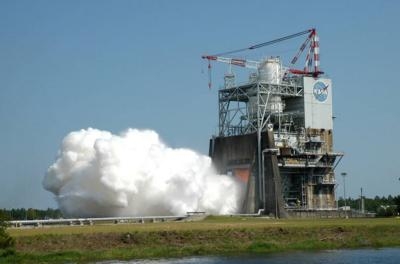Rocket Ran For 535 Seconds At Stennis Space Center
The RS-25 engine that will power NASA's Space Launch System (SLS) reached a key milestone on Thursday. The engine, built by Aerojet Rocketdyne, completed a full duration (535 seconds) verification test at NASA's Stennis Space Center, was the sixth test in a seven-test series that began in January 2015 to validate the engine for use on the SLS.

Operators on the A-1 Test Stand at Stennis are conducting the test series to qualify an all-new engine controller and put the upgraded former space shuttle main engines through the rigorous temperature and pressure conditions they will experience during a SLS mission.
"It is great to see this revered engine back in action and progressing full steam ahead for launch aboard Exploration Mission-1 in 2018," said Julie Van Kleeck, vice president of Aerojet Rocketdyne's Advanced Space & Launch Programs business unit. "The RS-25 is the world's most reliable and thoroughly tested large liquid-fueled rocket engine ever built."
The RS-25, previously known as the Space Shuttle Main Engine (SSME), successfully powered the space shuttle during 30 years of operation. The RS-25 uses a staged-combustion engine cycle that burns liquid hydrogen and liquid oxygen propellants to achieve performance never previously attained in a production rocket engine. Interestingly, the only exhaust produced by the RS-25 is water vapor in the form of steam.
The RS-25 will continue to serve the nation's human exploration propulsion needs as the core stage engines for SLS. The SLS program has 16 engines in inventory at Aerojet Rocketdyne's facility within NASA's Stennis Space Center, with 14 of them previously flown aboard the space shuttle.
"The engine that was tested today, development engine 0525, continues demonstration of the new controller's functionality and the engine's ability to perform to SLS requirements," added Jim Paulsen, vice president, Program Execution, Advanced Space & Launch Programs at Aerojet Rocketdyne. "We are conducting engine testing to ensure all 16 flight engines in our inventory meet flightworthiness requirements for SLS."
SLS will fly four RS-25 engines at the bottom of the core stage as opposed to three that flew on the space shuttle; the solid rocket boosters will be closer to the RS-25 engines than they were on the shuttle stack; and the taller SLS launch vehicle will result in higher propellant inlet pressure on the engine system. These changes, as well as operating them at 109% thrust means the engines will need to withstand more demanding conditions than when they were previously flown.
In addition to preparing for the new environmental conditions, the engines also are receiving a technology "refresh" of their controllers, which serve as the brains of the engines. The upgraded controller provides for communication between the vehicle and the engine, relaying commands to the engine and transmitting data back to the vehicle to regulate the thrust and fuel mixture ratio and monitor the engine's health and status.
"The new controller provides modern electronics, architecture and software," said Paulsen. "It will improve reliability and safety for the SLS crew as well as the ability to readily procure electronics for decades to come."
The first flight test of the SLS will be configured for a 70-metric-ton lift capacity and carry an un-crewed Orion spacecraft. As SLS evolves, it will be the most powerful rocket ever built and provide an unprecedented lift capability of 130 metric tons.
"SLS is the vehicle that will take astronauts to Mars and pre-position cargo for their survival," said Van Kleeck. "It is great to see that the red planet is one step closer and know our Aerojet Rocketdyne team is helping make that dream a reality."
 ANN's Daily Aero-Term (04.26.24): DETRESFA (Distress Phrase)
ANN's Daily Aero-Term (04.26.24): DETRESFA (Distress Phrase) ANN's Daily Aero-Linx (04.26.24)
ANN's Daily Aero-Linx (04.26.24) Airborne 04.22.24: Rotor X Worsens, Airport Fees 4 FNB?, USMC Drone Pilot
Airborne 04.22.24: Rotor X Worsens, Airport Fees 4 FNB?, USMC Drone Pilot Airborne 04.24.24: INTEGRAL E, Elixir USA, M700 RVSM
Airborne 04.24.24: INTEGRAL E, Elixir USA, M700 RVSM Airborne-NextGen 04.23.24: UAVOS UVH 170, magni650 Engine, World eVTOL Directory
Airborne-NextGen 04.23.24: UAVOS UVH 170, magni650 Engine, World eVTOL Directory



